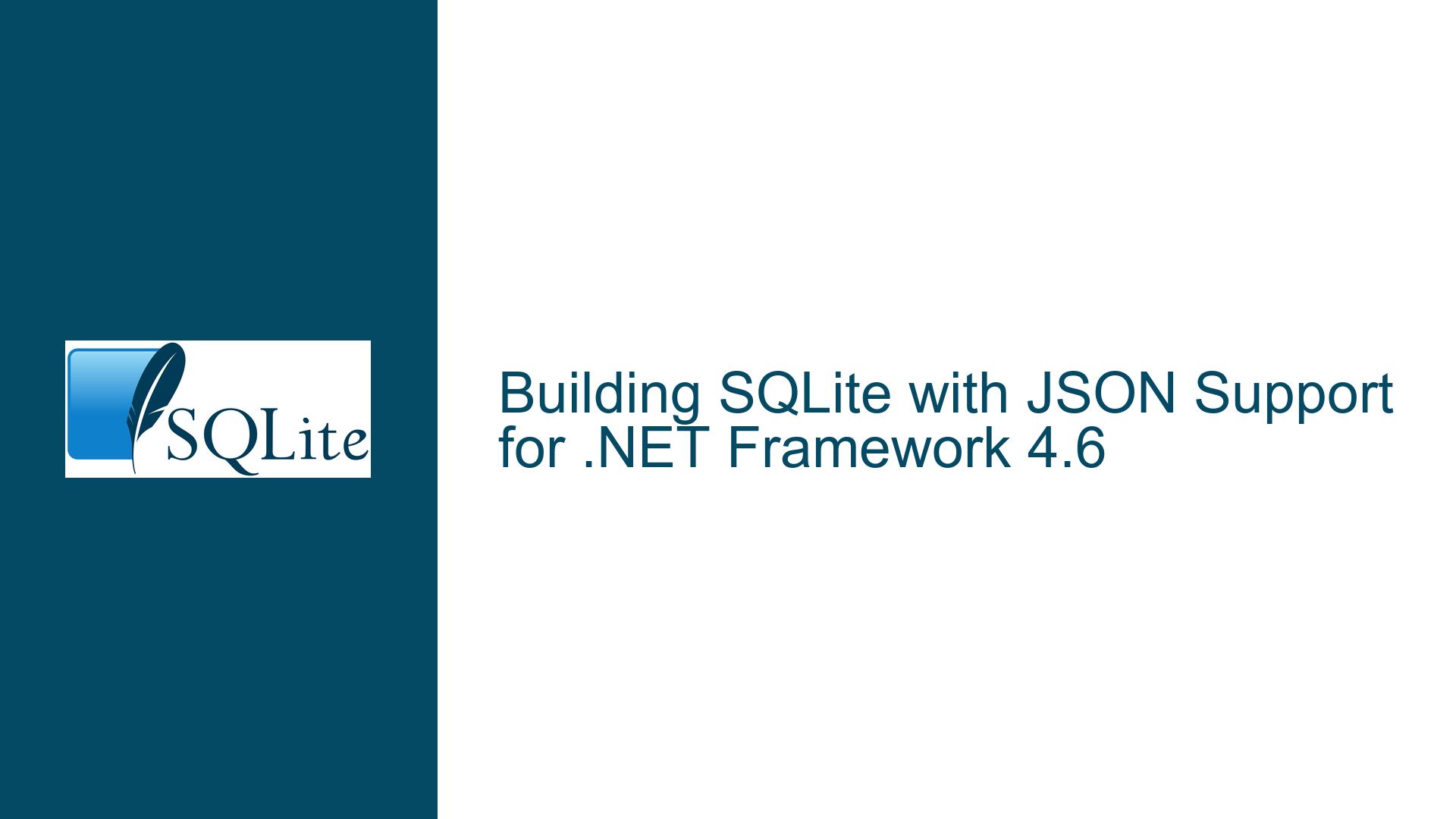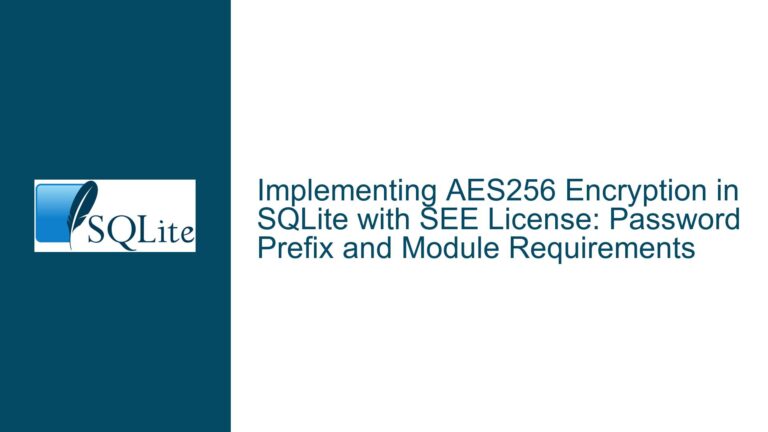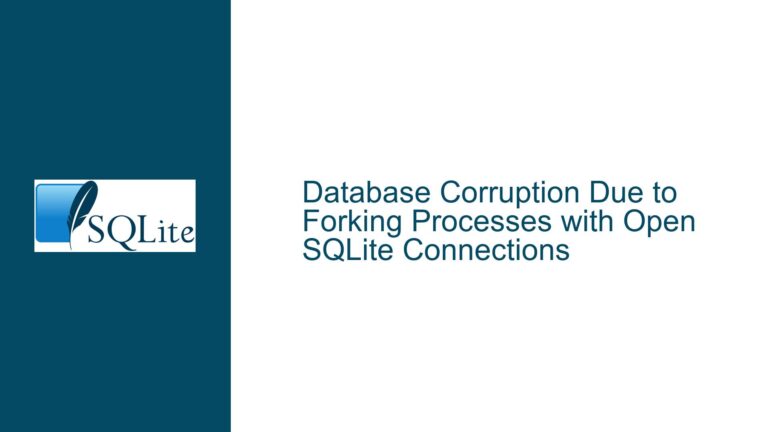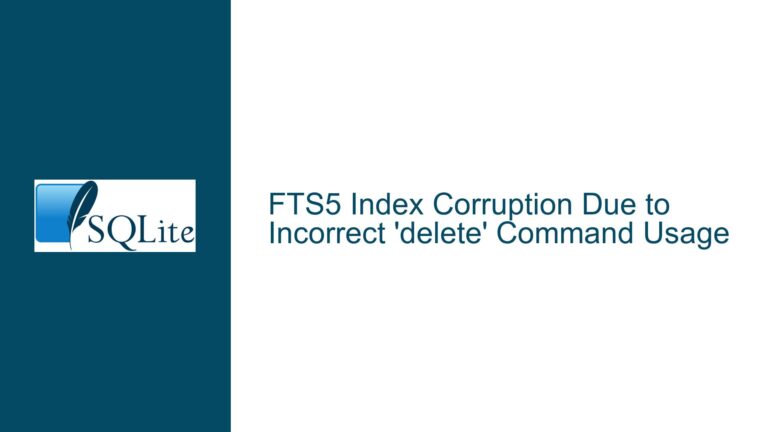Building SQLite with JSON Support for .NET Framework 4.6
JSON Functionality in SQLite for .NET Framework 4.6: Missing or Misconfigured Build
The core issue revolves around enabling JSON functionality in SQLite for applications running on the .NET Framework 4.6. The JSON support in SQLite is provided through the json1 extension, which must be explicitly enabled during the build process. However, users attempting to rebuild SQLite with JSON support for .NET Framework 4.6 encounter errors such as "SQL logic error no such function: json_object," indicating that the JSON functions are not available in the final build. This issue stems from a combination of missing build configurations, incorrect compilation flags, and potential mismatches between the SQLite core library and its .NET interop components.
The problem is further complicated by the fact that pre-built binaries for .NET Framework 4.6 with JSON support are not readily available. Users are forced to rebuild the SQLite library from source, which requires a deep understanding of the build process, the correct compilation flags, and the interplay between the SQLite core (sqlite3.dll), the .NET interop layer (SQLite.Interop.XXX.dll), and the .NET wrapper (System.Data.SQLite.dll). Without proper guidance, users often end up with a build that lacks JSON functionality or fails to integrate correctly with the .NET Framework.
Root Causes of JSON Functionality Missing in SQLite for .NET Framework 4.6
The absence of JSON functionality in SQLite builds for .NET Framework 4.6 can be attributed to several root causes. First and foremost, the JSON extension (json1) is not enabled by default in SQLite. It must be explicitly included during the build process by defining the appropriate compilation flag (SQLITE_ENABLE_JSON1). Many users attempting to rebuild SQLite overlook this critical step, resulting in a build that lacks JSON support.
Another common issue is the mismatch between the SQLite core library (sqlite3.dll) and the .NET interop layer (SQLite.Interop.XXX.dll). The interop layer acts as a bridge between the native SQLite library and the managed .NET environment. If the interop layer is not built with the same configuration as the core library, certain functions, including JSON functions, may not be exposed to the .NET application. This mismatch often occurs when users attempt to use a pre-built sqlite3.dll with a custom-built interop layer or vice versa.
Additionally, the build process for SQLite on .NET Framework 4.6 involves multiple steps, including configuring the solution file (SQLite.NET.2015.sln), setting the correct compilation flags, and ensuring that all dependencies are correctly referenced. Errors in any of these steps can lead to a build that either fails to compile or lacks the desired functionality. For example, the user in the discussion attempted to enable JSON support by adding #define INTEROP_JSON1_EXTENSION to SQLiteDefineConstants.cs, but this approach alone is insufficient without also enabling the corresponding flag in the SQLite core library.
Finally, the lack of up-to-date pre-built binaries for .NET Framework 4.6 with JSON support exacerbates the problem. Users are forced to rely on older versions of the library or attempt a custom build, both of which introduce additional complexity and potential for error.
Step-by-Step Guide to Building SQLite with JSON Support for .NET Framework 4.6
To successfully build SQLite with JSON support for .NET Framework 4.6, follow these detailed steps. This guide assumes you have a basic understanding of C#, .NET, and the SQLite build process. The goal is to produce a fully functional build of SQLite that includes JSON support and integrates seamlessly with .NET Framework 4.6.
Step 1: Download and Prepare the Source Code
Begin by downloading the latest source code for SQLite and the .NET wrapper from the official repositories. The source code for the .NET wrapper can be found at System.Data.SQLite. Ensure you download the full source package, which includes the SQLite core library, the .NET interop layer, and the .NET wrapper.
Extract the source code to a local directory and open the solution file (SQLite.NET.2015.sln) in Visual Studio. This solution contains all the necessary projects for building SQLite for .NET Framework 4.6.
Step 2: Enable JSON Support in the SQLite Core Library
To enable JSON support, you must modify the SQLite core library to include the json1 extension. Open the sqlite3.c file located in the SQLite core library project. Locate the section where compilation flags are defined and add the following line:
#define SQLITE_ENABLE_JSON1
This flag enables the JSON functions in the SQLite core library. Save the changes and rebuild the SQLite core library. This will produce a new sqlite3.dll with JSON support.
Step 3: Configure the .NET Interop Layer
Next, configure the .NET interop layer to expose the JSON functions to the .NET environment. Open the SQLiteDefineConstants.cs file in the interop layer project. Add the following line to enable JSON support in the interop layer:
#define INTEROP_JSON1_EXTENSION
This flag ensures that the JSON functions are included in the interop layer. Save the changes and rebuild the interop layer project. This will produce a new SQLite.Interop.XXX.dll that includes JSON support.
Step 4: Rebuild the .NET Wrapper
With the SQLite core library and interop layer configured, the final step is to rebuild the .NET wrapper (System.Data.SQLite.dll). Open the .NET wrapper project in Visual Studio and ensure that it references the updated sqlite3.dll and SQLite.Interop.XXX.dll. Rebuild the project to produce a new System.Data.SQLite.dll that includes JSON support.
Step 5: Verify the Build
To verify that the build was successful, create a simple .NET Framework 4.6 application that uses the new SQLite library. Add a reference to the rebuilt System.Data.SQLite.dll and write a test query that uses a JSON function, such as json_object. For example:
using System;
using System.Data.SQLite;
class Program
{
static void Main()
{
using (var connection = new SQLiteConnection("Data Source=:memory:"))
{
connection.Open();
using (var command = new SQLiteCommand("SELECT json_object('name', 'John')", connection))
{
var result = command.ExecuteScalar();
Console.WriteLine(result);
}
}
}
}
If the build was successful, the application should output the JSON object {"name":"John"}. If you encounter an error such as "no such function: json_object," double-check that the SQLITE_ENABLE_JSON1 flag was correctly set in the SQLite core library and that the interop layer and .NET wrapper were rebuilt with the updated libraries.
Step 6: Troubleshooting Common Issues
If the build fails or the JSON functions are not available, consider the following troubleshooting steps:
Ensure Consistency Across Libraries: Verify that the
sqlite3.dll,SQLite.Interop.XXX.dll, andSystem.Data.SQLite.dllare all built from the same source code and with the same configuration flags. Inconsistent builds can lead to missing or mismatched functions.Check Compilation Flags: Double-check that the
SQLITE_ENABLE_JSON1flag is correctly set in the SQLite core library and that theINTEROP_JSON1_EXTENSIONflag is set in the interop layer. Missing or incorrect flags are a common cause of missing functionality.Verify Dependencies: Ensure that the .NET wrapper project correctly references the updated
sqlite3.dllandSQLite.Interop.XXX.dll. Missing or outdated references can cause runtime errors.Clean and Rebuild: Perform a clean build of all projects to ensure that no stale binaries are being used. In Visual Studio, select "Build" > "Clean Solution" followed by "Build" > "Rebuild Solution."
Test in a Minimal Environment: Create a minimal .NET Framework 4.6 application to test the SQLite library. This helps isolate issues related to the build process from issues related to the application itself.
By following these steps, you should be able to successfully build SQLite with JSON support for .NET Framework 4.6. While the process is complex, careful attention to detail and thorough testing will ensure a functional and reliable build.






